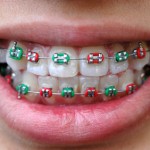
Comprehensive fixed appliance orthodontic treatment has an average duration of 20 to 30 months. From many years orthodontists have focussed on treatment mechanics as a main means of influencing orthodontic tooth movement (OTM) but only limited data exists. Yet recent research has focussed on interventions to increase OTM rates to reduce treatment time. Aligning the dentition is a key goal of orthodontic treatment and there are both multiple ways of measuring it and wide variation in quoted alignments times in different studies.
The main aim of this review was to determine the treatment duration required to achieve whole-arch alignment of the mandibular dentition using fixed appliances. Secondary objectives included the time to achieve incisor alignment in the mandibular arch and rates of alignment during each treatment phase.
Methods
A protocol was preregistered on the PROSPERO database. Searches were conducted in the Cochrane Database of Systematic Reviews, Cochrane Central Register of Controlled Trials, Medline, Embase, Scopus, Web of Science, Latin American and Caribbean Health Sciences Literature, and Database of Abstracts of Reviews of Effects without restrictions of language or publication year. Additional searches were made in the Directory of Open Access Journals, Digital Dissertations, meta- Register of Controlled Trials, Google Scholar and the reference and citation lists of eligible articles reviews. Randomised clinical trials (RCTs) of any comparison assessing duration and rate of mandibular tooth alignment were considered. Two reviewers independently screened and selected studies and extracted data with risk of bias being assesses with the Cochrane Risk of Bias 2.0 tool Random-effects meta-analyses of aggregate data, and individual patient data were conducted.
Results
- 35 RCTs involving 2258 patients were included.
- Trials were conducted in universities (18) hospitals (9) private practice (6) or practice and hospital (2).
- The trials were conducted in, Australia, Belgium, Brazil, China, Egypt, Greece, India, Iraq, Iran, Jordan, Syria, Turkey, United Arab Emirates, United Kingdom, and the United States.
- 30 RCTs were from multi-centre studies and 5 from single centres.
- 16 trials were non-extraction, 7 extractions only and 7 mixed with 6 not reporting on extraction.
- 20 trials were considered to be at low risk of bias, 5 at high risk and 10 at unclear risk.
| Alignment | No of studies | Duration (95%CI) |
| Mandibular whole arch | 4 | 263.0 days/8.8 months (6.2 to11.3 months) |
| Mandibular incisors | 9 | 100.7 days/3.4 months (2.8 to 3.9 months) |
Conclusions
The authors concluded: –
The pooled duration for whole-arch alignment in the mandible was 263.0 days, whereas mandibular incisor alignment was achieved in 100.7 days. Extreme heterogeneity was observed across studies for all indirect pooling. Individual patient data analysis from 3 RCTs showed patient age significantly associated with increased duration for the alignment of >7.0 mm irregularity, whereas for irregularity <7.0 mm, duration of alignment was extended for every mm of baseline irregularity. Future research studies investigating rates of orthodontic tooth alignment would benefit from adequate sample sizes and a more consistent methodology in outcome assessment. Data in this systematic review provides a basis for appropriate trial design for future RCTs investigating the rate of orthodontic tooth alignment with fixed appliances.
Comments
The review authors published their review protocol on the PROSPERO database a priori and have undertaken an extensive database search with no limitations of language or publication year. They have chosen to focus on whole-arch (complete) alignment of the mandibular dentition measure as irregularity is most commonly measured in interventional trials. A standard systematic review methodology has been followed with variations from the original protocol being noted in the supplemental material. 35 RCTs were included with 20 (57%) being considered to be at low risk of bias. There was however marked heterogeneity in the studies related to the various clinical settings, malocclusions, extractions and treatment methods. While the main focus of the review is the duration of mandibular whole arch and incisor alignment a number of other analyses are presented and this review represents a significant amount of work and as the authors’ suggest will help contribute to improving the design of future RCTs.
Links
Primary Paper
Wazwaz F, Seehra J, Carpenter GH, Ireland AJ, Papageorgiou SN, Cobourne MT. Duration of tooth alignment with fixed appliances: A systematic review and meta-analysis. Am J Orthod Dentofacial Orthop. 2021 Nov 16:S0889-5406(21)00560-6. doi: 10.1016/j.ajodo.2021.06.016. Epub ahead of print. PMID: 34794862.
Other references
How long does it take to align teeth – Kevin O’Brien’s Orthodontic Blog – 29th Nov 2021
Dental Elf – 26th Oct 2020
